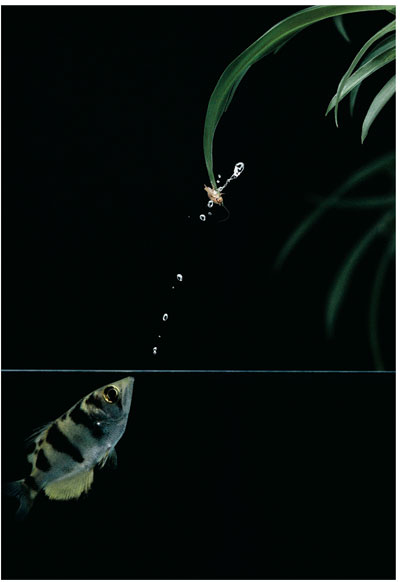Watch and Learn
By Christopher Brodie
Benchwarming pays off for the archer fish
Benchwarming pays off for the archer fish

DOI: 10.1511/2006.59.218
People who throw things for fun or profit—basketball and baseball players, the guy who slings darts at the pub—should respect the archer fish. This species blasts its insect prey out of the sky or off a perch with a quick squirt of water that's accurate up to two meters away (not bad for a fish that averages 25 centimeters in length).

G. I. Bernard/Photo Researchers, Inc.
However, these animals start with lousy aim, so they have to acquire the skill over time. What's amazing is that archer fish don't have to rehearse their piscine field goals: They can learn how to hit a fast-moving, flying object by watching another fish do so, according to a paper in the February 21 issue of the journal Current Biology. Imagine a fan who watches a season of hoops on TV, then picks up a basketball and sinks a 40-foot jump shot.
Stefan Schuster and his colleagues at Friedrich-Alexander University of Erlangen-Nuremberg discovered this unusual ability when they set out to study how archer fish hit their prey so accurately. The investigators regularly presented small, stationary targets at various heights to young fish, which became quite good at knocking them down over the course of a year. However, a moving target flummoxed them, even when it was going very slowly (five millimeters per second, or about twice as fast as a speeding snail).
With time and extensive training (hundreds of repetitions), the archer fish got better at hitting targets that moved horizontally at constant speed. This feat requires a tricky bit of neural computation that has to account for several variables: the target speed and direction, the changing angle between observer and target (which determines how much light is bent, or refracted, at the air-water boundary), the time of flight and the effect of gravity. As the fish became proficient, each increase in target height or speed erased most of the previous gains in accuracy until the shooter could adjust its calculations.
Based on this pattern, the investigators were surprised to find that the ballistic solution painstakingly learned and revised for horizontal movements could easily accommodate the addition of a vertical component. For archer fish, it seems, movement in three dimensions isn't any more difficult to follow than movement in two dimensions.
Nonetheless, the German team was unprepared for what happened when they began another round of training with a group of five fish unfamiliar with the moving-target game. This trial must have seemed like a busted experiment at first, as the dominant member of the group hogged all the shots and wouldn't let his subordinates line up for even a single attempt at the target. As expected, the one performing fish had learned its skills just fine by the end of training. But when Schuster's team removed the varsity player, the benchwarmers—fish that had previously failed to hit even the lowest, slowest targets and hadn't taken a single shot during the practice sessions—showed nearly the same ballistic prowess as their former leader.
One possible explanation was that the nondominant fish figured out all the angles simply by watching the target while the alpha trained. But in a control group without a dominant fish (experimenters played the same role by nudging the others out of firing position during the training), the spectators performed just like spectators, with dismal hit rates. In other words, the naive fish had to learn by watching a successful group member, and this observation apparently told them all they needed to know about refraction, target speed, rise time and gravity effects.
Archer fish don't have impressive neural hardware to process all this information; like other fish, they have a primitive cerebrum, so the means of performing these computations must already exist in simple nervous systems. At present, Schuster's team is working to identify the neuroanatomical circuits, but he doesn't expect to find distinctive features. The major goal is to "get [our] hands on how a defined network performs in a cognitive task," he says.
His success could be something of a breakthrough: Computational neuroscientists have spent decades figuring out how animals learn new motor skills, and most of their models use some kind of feedback routine that tries to minimize error with each new repetition—what engineers call a "closed-loop" design. But shots from the archer fish are "open-loop"—they don't involve continuous feedback. "That's what I find most challenging," says Schuster, "the fact that [the task] can be done extremely fast and with remarkable precision without adhering to traditional closed-loop design. We hope very much to convince researchers in robotics that much speed can be saved by implementing predictive (or ballistic) shortcuts in the motor guidance of autonomous robots."
Fish aren't particularly smart, but archer fish do seem to have a fairly sophisticated cognitive ability to generalize from one set of circumstances to another and to make predictions based on that general knowledge. They clearly acquire this skill more efficiently than we humans figure out how to swish a three-point shot or to throw a wicked curveball. Can we learn from the fish? Well, Dr. J is a Pisces. And Adrian Dantley, Charles Barkley and Shaquille O'Neal are too. So I guess the answer is yes.
Click "American Scientist" to access home page
American Scientist Comments and Discussion
To discuss our articles or comment on them, please share them and tag American Scientist on social media platforms. Here are links to our profiles on Twitter, Facebook, and LinkedIn.
If we re-share your post, we will moderate comments/discussion following our comments policy.